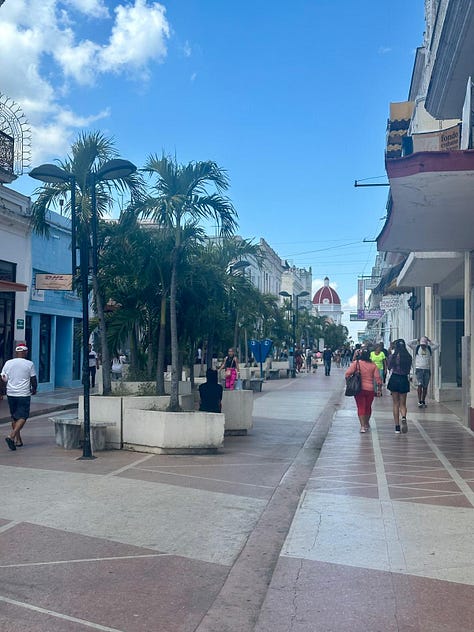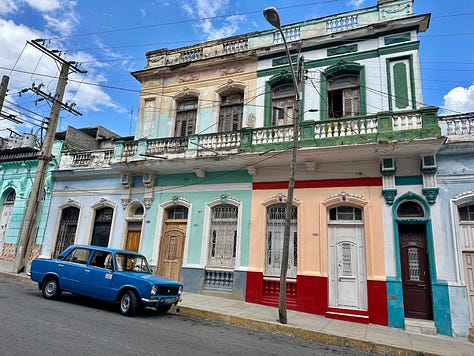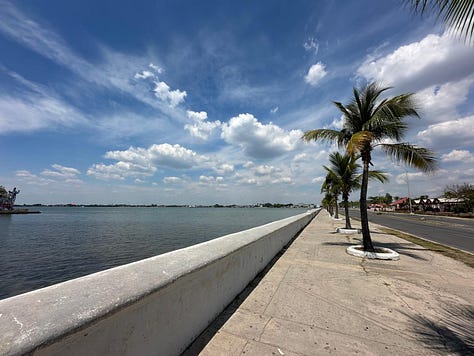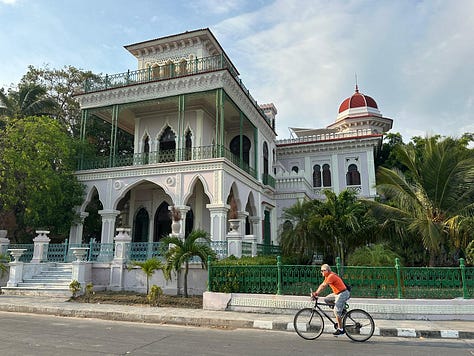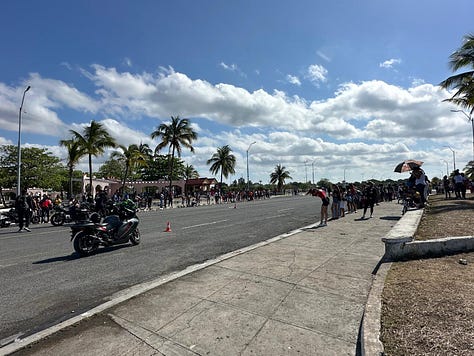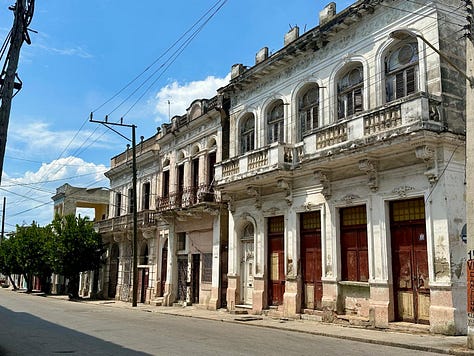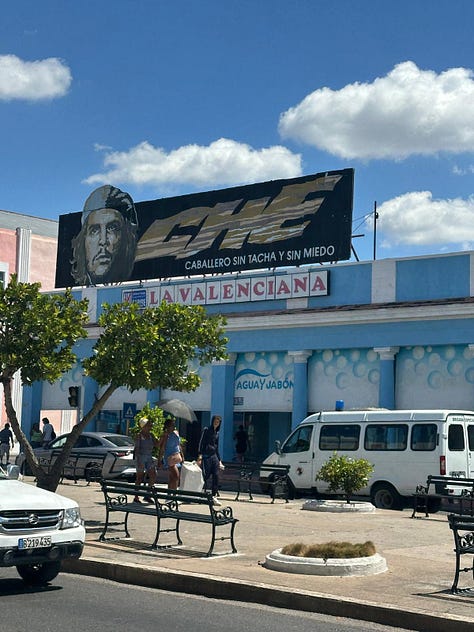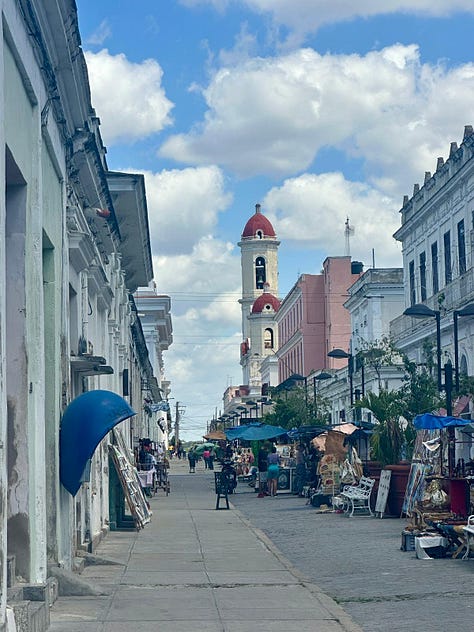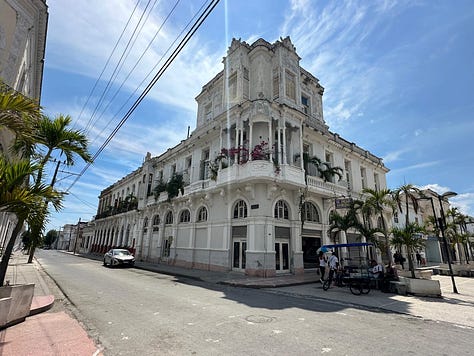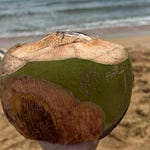In the podcast Alex narrates the story then we talk about our experience in the city of One Hundred Fires. You can read the story below and view the photo gallery after.
I start on Malecon, the main boulevard connecting Punta Gorda to the center of Cienfuegos. The Malecon is busy on the weekends and for an hour before sunsets, but in the morning it is mine. Only a few electric tuk-tuk taxis, and a smoky car or two.
I run between the Cienfuegos Bay and the parks, among palms and potholes, and through the memories of my youth. No palm trees in my teenage years but the potholes and the strife of life in a communist country. Deficits, limited future, and creative ways to have fun without the amenities to spend your money, or without the money to spend. Cuba reminds me of too much.
I ran the Malecon three times since we arrived last week, and I am looking for something new. I turn away from the bay and towards the only high-rise apartment building to the East. It is no higher than twelve stories tall, yet the most prominent feature for miles.
I zig-zag towards it. A right turns me directly into the sun and its growing heat. A left brings me into the shade of the low-slung two-story homes. Calling these “two-story” oversells their size. They are tiny, two rooms stacked above each other, with the second floor offset to make room for a balcony. Once bright in magenta, yellow, light blue, and rose, they are now grey, the color of crumbling concrete, with the evidence of old paint as stubborn flakes refusing to let go.
An elderly man sits in a chair on the flat roof of the first floor. It is not like a balcony as it is open to the sky. Nor like a patio as it has no rails. Just a flat section of roof in front of the second-story room offset to the back of the home. Two children exit the door underneath the old man, parents follow them out, then the grandma. I assume they are a single family, all living in a tiny home.
Such concentrated living is a plight of Communism and a plight of poverty. I saw “Komunalki” in old Soviet Union. They were the four or five-bedroom apartments that housed multiple families. Before the revolution of 1917, a large family owned each flat. After the revolution, in a version of people’s justice, half of that family was thrown out on the street, and the other half “disappeared” into the camps or to the mass graves. Other four families moved in, a family to a room, four families to a toilet. I wonder how the Cuban revolution managed that transition.
I run into a busier avenue. The high rise is two blocks away, but dead-end streets and fences block my path. I turn and run along a stream of walkers. They are packing the sidewalk, so I run on a road against the traffic, between people and cars.
Most people are in uniforms on this block. There are nurses in white dresses, white stockings, and white hats, as if from a World War I movie set. There are boys in blue shorts and white shirts, and girls in blue skirts and white shirts. Girls wear white knee-high socks. Both wear little red pioneer ties tucked under the white collars. They could be from a Soviet propaganda film about happy children marching to school.
In two blocks, I see the school on my left and the hospital on my right. The uniforms make sense now. In two more blocks, the uniforms change to the military greens of interior ministry, and the universal uniform of office workers: skirts and blouses with heels. Although, I don’t see dressed-up men. I can’t explain it.
The traffic is busy on the main streets. It is hard to breathe. The pollution is in my lungs. The morning humidity smothers the smog and keeps it hovering near the ground. I can smell it and feel it in my lungs. It acts like altitude hypoxia suppressing my breathing and slowing my running pace. I turn onto a small street past a busy bus station. The stench of pollution lessens.
I run into a crowd of kids. They are younger, elementary school-age, but wear the same uniforms as the other schoolchildren, only the ties are light blue.
I remember the red ties, but not the blues of the young kids. In elementary school, we wore a lapel pin - a red shiny star with a gold bust of Lenin in the middle. We were the young “Octobrist,” then young “Pioneers” after the third grade when we graduated to red ties. I slow to ask the kids what they call themselves but I realize I don’t have the vocabulary for a chat about dogma.
I climb a hill and pass a horse carriage. Six people are in the cart, mostly well dressed, three on each side, facing each other. “Taxi de Caballo” is hand-painted on the boards of the cart in a well-executed font. The man prods a diminutive horse, or a mule, to pull up the hill, and it does, yet slower than me. The fact that it does at all, astounds me. Then the carriage passes me on the downhill. How does it stop?
I run toward the city center. I see less color of concrete and more paint on the homes. A few buildings grow taller, up to three stories, some grow wider. The ubiquitous anti-theft cages on windows and doors are more ornate and painted black. They show no rust of poverty.
I pass a newer Mercedes, a lightly used GMC pickup truck, an old Soviet Lada, a Czech Java motorcycle with a sidecar, a 1950s well-used Chevy, and two more horse carriages. Two centuries of transportation in two regular blocks. The past, present, and future.
They simultaneously exist in Cuba in a nod to physics’ theory of Eternalism. The flow of time is an illusion, it says. Past, present, and future all exist at once, laid out across time, comfortably coexisting. The idea was born from a theory - the scientific revolution of Einstein’s special relativity. Cuba’s Eternalism was born from a failed experiment, a people’s revolution, grown from aspirations of equality but fizzled from the mandates of realities and reluctant human nature.
A motorcycle nearly hits me at a cross street. He beeps and swerves. I jump back to the curb and resolve to run without esoteric diversions. The tourist city center is too busy for that. The chaos is already on the streets.
“Cambio, cambio,” a man hollers at me. He offers to exchange my dollars for pesos. Why me? I am in a running tank top, hat, and running shorts. Where would I keep the money? But I am white, and I am running. I have not seen Cubans run here. I am a foreigner indeed. Why not try yelling at me?
I jump over a gap between the road and a curb. It is a foot deep and is common on roads with sidewalks. When the city lays a new layer of asphalt to improve the road, it does so directly on top of the old, without the hassle of grinding and hauling the asphalt out. Efficient, and dangerous. The road repairs grow the road taller, the asphalt layers divulging its age like a cut-down tree.
The downtown square is beautiful. The description of Cienfuegos's Spanish colonial architecture is in every tour book. I will leave it out. But under the trees, next to a statue of some once-important fellow, I see a scene of note. A young man and a young woman, in their school uniforms and their red ties, are in a tight embrace. They look into each other’s eyes and kiss. Ten yards away, another girl in a red tie is smoking on a bench and stares at the couple. She looks at a girl in a hug and clenches her fist. She clenches her jaw. She looks at a guy and her features soften. Well, shit. The story is the same world all over.
I laugh inside. And then I think of their future. These young people believe it is in their hands. I silently urge them to act on their hopes before life’s disappointments morph them into the complacent fatalism of the adults. Their futures ought not to be determined, not by governments nor by physics. Forget Eternalism, predestination, and fate, and let them choose what they want to be, and what their country can be. Let them have the agency to steer their future and break through the restrictions of ideologies and stifling embargoes of the West.
